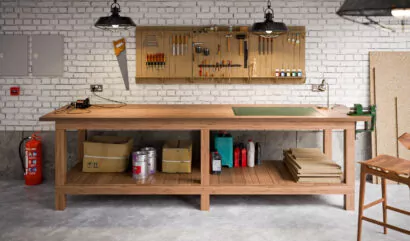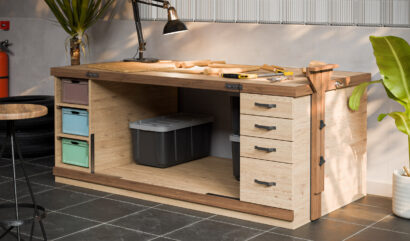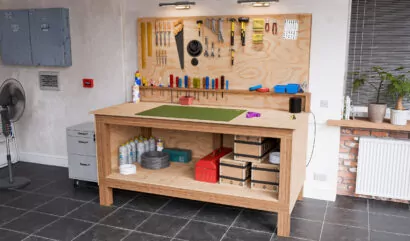Choosing the right workbench: A practical guide
A well-designed workbench is the foundation of any productive workshop. Whether you’re a weekend woodworker or an experienced do-it-yourselfer, you can dramatically boost your enjoyment and improve your quality of work with the right workbench design. The following guide lists key considerations to ponder while choosing among Craftcamp’s free workbench plans.
Understanding your workbench needs
Your workbench should reflect how you intend to use it. If you primarily use hand tools, you might benefit from a solid, heavy bench that won’t shift during hand planing and chiseling. If you primarily use power tools, you will want a stable surface at a convenient height. Is your workbench specifically tailored for a particular purpose, or is it more of a general-purpose service for various projects and household repairs? Your primary activities will guide many of your design choices.
Space constraints are also tremendously important. While a dedicated workshop allows for a large permanent installation, a small garage, shed or shared space might require a folding or mobile workbench. You should remain realistic about your available room when choosing a workbench design.
Classic workbench designs
Simple 2×4 Workbench
One of the most popular and accessible designs for beginners, this workbench is primarily made from standard construction lumber and plywood. It offers a solid work surface without requiring advanced woodworking skills to build. More advanced designs often include a lower shelf for storage. Affordable and easy to make, the Simple 2×4 Workbench is designed to provide years of reliable service at a very reasonable cost.
Traditional Hardwood Workbench
If you have significant woodworking experience, this workbench plan can deliver increased durability with convenient design elements, such as a mounted bench vise and dog holes (small holes drilled across the surface for securing work with drop-in bench dogs). These benches typically feature a solid hardwood top that can withstand decades of use. While more complex to build than a simple 2×4 bench, the Traditional Hardwood Workbench offers superior tool-holding and work-holding capabilities for serious woodworking projects.
Wall-Mounted Folding Workbench
Great for work areas with limited floor space, these clever designs attach securely to wall studs, which allow them to be folded down when needed and folded up when not in use. Though typically not as solid and sturdy as permanent workbenches, a well-built folding bench can handle most household projects and basic woodworking tasks.
Key design elements to consider
Workbench height
Although you should pay close attention to all the physical dimensions of your workbench, the height of your work surface is perhaps the most important. It can have a critical impact on your ability to work comfortably and productively, so you should tailor your workbench’s height to support your primary activities. For general woodworking with hand tools, many craftspeople prefer a bench height where their knuckles just touch the surface when standing relaxed with arms at their sides (typically 33 to 36 inches for individuals of average height). For fine woodworking or primarily power-tool use, a higher bench (typically 38 to 42 inches for individuals of average height) might be more appropriate. Remember that it is fairly easy to add risers or otherwise adapt a bench that is slightly too low. It can be quite difficult, however, to adapt a bench that is too high.
Work surface material
The primary material of your work surface can have a profound effect on the functionality of your workbench. Solid hardwood tops offer the best combination of mass and durability while readily supporting attached vises and other fixtures. Plywood creates a flat, stable surface at a lower cost, but it may not hold up well under heavy pounding or clamping. Some workbenches use medium-density fiberboard (MDF) with a hardboard or laminate surface, offering excellent flatness and reasonable durability for light to medium work. For general-purpose benches, a top that measures 1 1/2 to 2 inches thick can generally provide a good combination of strength and economy.
Work-holding capacity
How do you plan to secure materials to your workbench? This factor will determine your work-holding capacity. From traditional woodworking vises to modern quick-release clamps to simple bench dogs, you can outfit your bench with many different work-holding methods. Because a bench without good work-holding capabilities will prove frustrating even for basic projects, you should carefully determine how you’ll secure various sizes and shapes of materials before finalizing your bench design.
Workbenches for different settings
Garage workshop benches
Garage spaces often serve multiple purposes, so garage workshop benches benefit from mobility features such as wheels with locking casters. A substantial top thickness of 1 1/2 inches or more can add stability to these mobile benches and dampen vibration from power tools. Height should accommodate standing work for extended periods, typically 36 to 38 inches for most users. An open design underneath can accommodate tool storage or a rolling cabinet.
Small space solutions
The right workbench design can help you pack a tremendous amount of functionality into a very small space. Wall-mounted folding benches work well for this, as do compact benches with vertical storage incorporated into a backboard. Another approach is a modular system where workbench components can nest together when not in use or separate to create extended work surfaces when needed. In tight spaces, a multipurpose approach is key, so look for designs that can serve as assembly tables, tool stands, and material support.
Dedicated woodshop benches
If mobility and size constraints are of little concern, you can design without compromise, tailoring your workbench to enhance whatever types of woodworking you favor. These dedicated woodshop benches typically feature thick tops of 2 to 3 inches or more, robust work-holding options, including front and end vises, and extensive dog hole patterns to serve a variety of purposes. Since this bench won’t need to be moved frequently, mass becomes an advantage, helping to absorb vibration and resist movement during hand planing, heavy work or use of benchtop machinery. Traditional joinery, such as dovetailed corners or mortise-and-tenon joints, can add both strength and quality detail.
Building considerations
Material selection
While choosing the material for your workbench, you must balance cost, durability and aesthetics. Benches are traditionally composed of hard and durable wood, such as maple, beech and ash. Budget-conscious builders might opt for construction-grade pine or fir, both of which can create serviceable benches, particularly when doubled or tripled for tops. Plywood also offers good stability and strength, particularly for benches that will see mainly power tool use. You might also want to blend materials. For example, an MDF core with hardwood edges combines economy with durability where it matters most.
Joinery complexity
Because joinery can be challenging, woodworkers should carefully choose their joinery techniques based on their current skill level and available tools. Simple workbenches can be built entirely with butt joints reinforced by glue and screws, making them accessible to beginners with basic tools. More advanced designs might incorporate mortise-and-tenon joints, half-lap joints, or dovetails for increased strength.
Future adaptability
Workbenches are generally easy to alter and augment over time. Therefore, you might want to start with a basic bench and add features later as your skills and needs evolve. Designing with future modifications in mind (such as pre-planning for vice installation or ensuring the frame can support additional weight) creates a bench that grows along with your woodworking journey. Consider how your needs might change, and build in adaptation points where possible.
Popular workbench styles in our free plans
Heavy-Duty 2×4 Workbench
This design uses a grid-work of standard construction lumber to create a torsion-resistant frame that supports a double-layer plywood top. While it requires only basic tools and skills to construct, it provides a work surface that is sturdy enough for serious projects. The integrated lower shelf offers valuable storage space, and the design can be easily modified to include simple work-holding solutions.
Classic Hardwood Workbench
Featuring a solid top constructed from laminated hardwood boards, this aptly-named bench design incorporates time-tested elements such as a front vise, an end vise, and a systematic grid of dog holes for versatile work-holding. Though more involved to build than simpler designs, the result is a bench that excels for traditional woodworking while serving as a beautiful centerpiece in your workshop. Even if you are relatively new to fine woodworking, you can create strong, traditional joinery by following the instructions in this plan.
Fold-Down Wall-Mounted Workbench
With a mounted design, this workbench attaches securely to wall studs and folds down to create a sturdy surface whenever needed. Though not as big as free-standing benches, the clever bracing system ensures stability during use. The plan for this bench includes options for integrated tool storage on the underside of the work surface, maximizing utility even in the most space-restricted settings.
Mobile Project Center
Built on locking casters, this bench moves easily around your shop or garage, then locks firmly in place during use. The design features a solid top with integrated clamping options and can double as an outfeed table for stationary tools. Multiple storage options keep tools accessible, and the adjustable-height feature accommodates different types of work. This versatile design works particularly well in shared and multi-use spaces, such as garages, carports, and storage sheds.
Making your final selection
When choosing among workbench plans, consider where you are in your DIY journey and what kind of projects you’ll tackle next. Starting with a bench that matches your abilities ensures a successful project and a useful tool. Think about the projects you’re most likely to tackle in the next year or two, not just aspirational future projects. Remember:
- You should prioritize features that support your regular work rather than specialized capabilities you might rarely use.
- You can always build a more complex bench, or second workbench, as your skills develop.
- Many woodworkers build multiple benches throughout their journeys.
Your first bench doesn’t need to be your forever bench. It just needs to serve your current needs well while helping you develop skills for future projects. Choose a Craftcamp plan that you can complete with your current tools and abilities, and that will provide a solid foundation for all of your future woodworking and DIY adventures.










